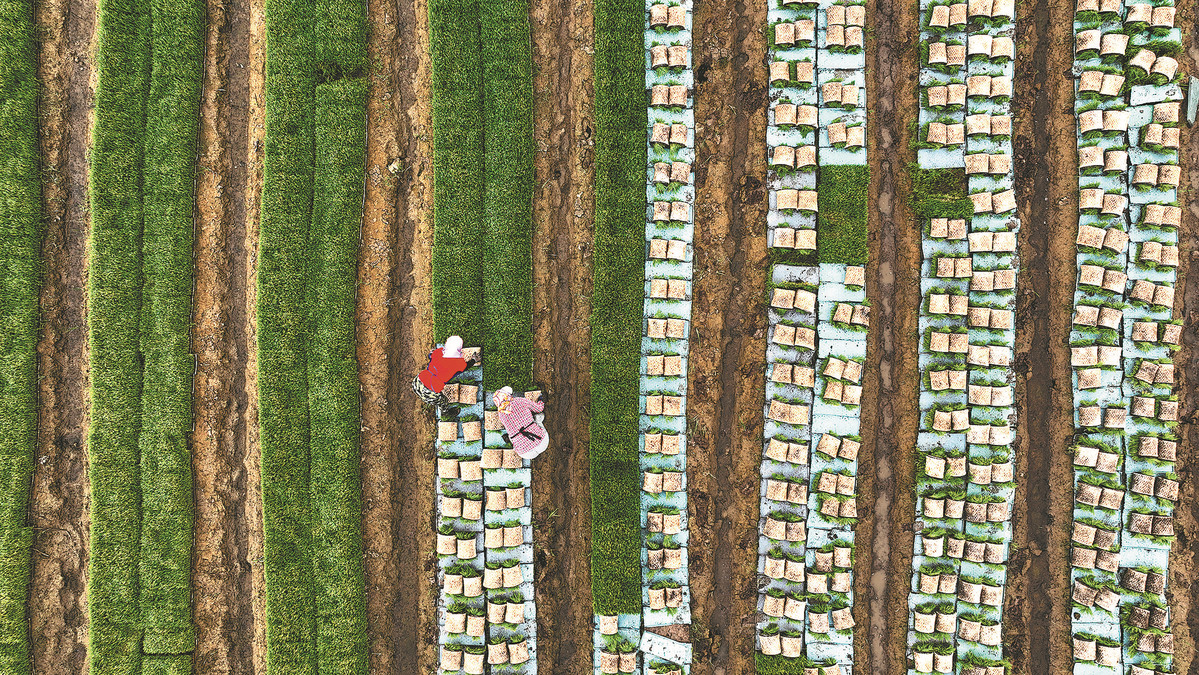Seeds of hope spring from seawater rice
Farmers collect seawater rice seedlings at a farm in Lianyungang, Jiangsu province, in June. WANG CHUN/FOR CHINA DAILY
Crops help produce more arable land for nation
The importance of food security was emphasized in autumn by Xi Jinping, general secretary of the Communist Party of China Central Committee.
In his report to the Party's 20th National Congress, he said, "We will ensure that China's food supply remains firmly in its own hands."
Xi also underlined the Party's determination to ensure that China's total area of farmland does not fall below 120 million hectares.
Agricultural experts stressed the importance of guarding this bottom line firmly and also advised turning another 100 million hectares of saline-alkali soil, also known as saline soil, into arable land. This soil contains so much salt that barely any crops can be grown on it.
Liu Jiayin, director of the Qingdao Saline-Alkali Tolerant Rice Research and Development Center, said: "Most crops die if the salt content in water is more than 0.2 percent. The amount of salt in saline soil ranges from place to place in China, but it is above that level, thus making it hard to support the growth of crops."
Data from the center show there are 950 million hectares of saline land globally. Some 22 percent of this land is in East Asia, and China has 100 million hectares of saline soil and 128 million hectares of arable land.
Some 6.67 million hectares of saline land is located in coastal areas around Bohai Bay and near the southeast coast. This land, the result of coastal erosion, will retain its salt content for a long time.
The nation's northeastern provinces, where the winter permafrost is more than 1 meter deep, are home to about 10 million hectares of saline land. In spring, water on the surface evaporates, but deeper down it remains frozen and cannot escape. As a result, salt accumulates and the soil becomes saline.
A further 66.67 million hectares of such land is located in the northwest, where there is so little rainfall that salt on the surface is seldom washed away.
Wei Ke, an associate researcher at the Chinese Academy of Sciences' Institute of Atmospheric Physics, said annual rainfall of 400 millimeters divides "wet" and "dry" regions, while 200 mm of rainfall a year determines "dry" and "very dry" areas.
 |
Photos
Related Stories
- China to improve functions of agriculture and rural affairs ministry
- UN official says Chinese Juncao technology holds key potential to contribute to achievement of UN SDGs
- Intelligent agriculture drives rural vitalization in NW China’s Ningxia
- Zengcheng in S China's Guangzhou pursues high-quality development of agriculture
- Farmers in NW China’s Qinghai celebrate start of spring farming
- Chinese rice production expertise impresses Malawian authorities
- Locals in C China's Fu'an Village receive drone operation training for spring ploughing
- Smart farming advances China's modern agricultural development
- Spring farming underway across China
- Spring plowing boosted by State measures
Copyright © 2023 People's Daily Online. All Rights Reserved.










